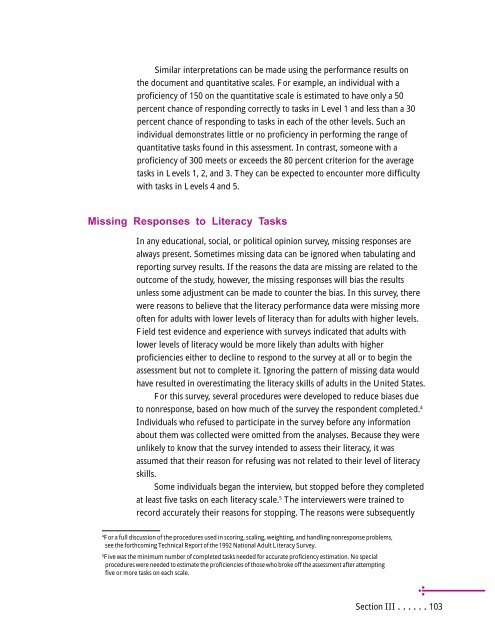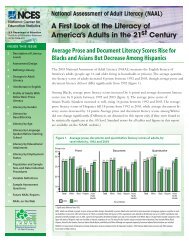Adult Literacy in America - National Center for Education Statistics ...
Adult Literacy in America - National Center for Education Statistics ...
Adult Literacy in America - National Center for Education Statistics ...
Create successful ePaper yourself
Turn your PDF publications into a flip-book with our unique Google optimized e-Paper software.
Similar <strong>in</strong>terpretations can be made us<strong>in</strong>g the per<strong>for</strong>mance results on<br />
the document and quantitative scales. For example, an <strong>in</strong>dividual with a<br />
proficiency of 150 on the quantitative scale is estimated to have only a 50<br />
percent chance of respond<strong>in</strong>g correctly to tasks <strong>in</strong> Level 1 and less than a 30<br />
percent chance of respond<strong>in</strong>g to tasks <strong>in</strong> each of the other levels. Such an<br />
<strong>in</strong>dividual demonstrates little or no proficiency <strong>in</strong> per<strong>for</strong>m<strong>in</strong>g the range of<br />
quantitative tasks found <strong>in</strong> this assessment. In contrast, someone with a<br />
proficiency of 300 meets or exceeds the 80 percent criterion <strong>for</strong> the average<br />
tasks <strong>in</strong> Levels 1, 2, and 3. They can be expected to encounter more difficulty<br />
with tasks <strong>in</strong> Levels 4 and 5.<br />
Miss<strong>in</strong>g Responses to <strong>Literacy</strong> Tasks<br />
In any educational, social, or political op<strong>in</strong>ion survey, miss<strong>in</strong>g responses are<br />
always present. Sometimes miss<strong>in</strong>g data can be ignored when tabulat<strong>in</strong>g and<br />
report<strong>in</strong>g survey results. If the reasons the data are miss<strong>in</strong>g are related to the<br />
outcome of the study, however, the miss<strong>in</strong>g responses will bias the results<br />
unless some adjustment can be made to counter the bias. In this survey, there<br />
were reasons to believe that the literacy per<strong>for</strong>mance data were miss<strong>in</strong>g more<br />
often <strong>for</strong> adults with lower levels of literacy than <strong>for</strong> adults with higher levels.<br />
Field test evidence and experience with surveys <strong>in</strong>dicated that adults with<br />
lower levels of literacy would be more likely than adults with higher<br />
proficiencies either to decl<strong>in</strong>e to respond to the survey at all or to beg<strong>in</strong> the<br />
assessment but not to complete it. Ignor<strong>in</strong>g the pattern of miss<strong>in</strong>g data would<br />
have resulted <strong>in</strong> overestimat<strong>in</strong>g the literacy skills of adults <strong>in</strong> the United States.<br />
For this survey, several procedures were developed to reduce biases due<br />
to nonresponse, based on how much of the survey the respondent completed. 4<br />
Individuals who refused to participate <strong>in</strong> the survey be<strong>for</strong>e any <strong>in</strong><strong>for</strong>mation<br />
about them was collected were omitted from the analyses. Because they were<br />
unlikely to know that the survey <strong>in</strong>tended to assess their literacy, it was<br />
assumed that their reason <strong>for</strong> refus<strong>in</strong>g was not related to their level of literacy<br />
skills.<br />
Some <strong>in</strong>dividuals began the <strong>in</strong>terview, but stopped be<strong>for</strong>e they completed<br />
at least five tasks on each literacy scale. 5 The <strong>in</strong>terviewers were tra<strong>in</strong>ed to<br />
record accurately their reasons <strong>for</strong> stopp<strong>in</strong>g. The reasons were subsequently<br />
4 For a full discussion of the procedures used <strong>in</strong> scor<strong>in</strong>g, scal<strong>in</strong>g, weight<strong>in</strong>g, and handl<strong>in</strong>g nonresponse problems,<br />
see the <strong>for</strong>thcom<strong>in</strong>g Technical Report of the 1992 <strong>National</strong> <strong>Adult</strong> <strong>Literacy</strong> Survey.<br />
5 Five was the m<strong>in</strong>imum number of completed tasks needed <strong>for</strong> accurate proficiency estimation. No special<br />
procedures were needed to estimate the proficiencies of those who broke off the assessment after attempt<strong>in</strong>g<br />
five or more tasks on each scale.<br />
Section III ......103



